Design and Preparation of a 6-Channel Fan-Shaped Integrated Narrow-Band Filter in the Mid-Infrared Band
Abstract
:1. Introduction
2. Basic Principle and Film Design
3. Experiments
4. Results Discussion and Comparison
5. Conclusions
Author Contributions
Funding
Acknowledgments
Conflicts of Interest
References
- Yang, G.P.; Yu, X.C.; Feng, W.F.; Liu, W.; Chen, W. The development and application of hyperspectral RS technology. Bull. Surv. Mapp. 2018, 10, 1–4. [Google Scholar]
- Yang, Y.Z.; Cao, W.X.; Sun, Z.H.; Wang, G.F. Development of real-time hyperspectral radiation sea-observation system. Acta Opt. Sin. 2009, 29, 102–107. [Google Scholar] [CrossRef]
- Wen, Z.Y.; Chen, G.; Wang, J.G. The project and simulation of a compositive miniature spectrum instrument based on the array of Fabry-Perot cavity. Spectrosc. Spectr. Anal. 2006, 26, 1955–1959. [Google Scholar]
- Lei, Y.; Ming-ming, X.; Jie-xiang, C.; Hui, X. Optical system of the hyper-spectral imager for the underwater environment and targets monitoring. Acta Photonica Sin. 2018, 47, 3071. [Google Scholar]
- Cao, H.Y.; Gao, H.T.; Zhao, C.G. Development of china land quantitative remote sensing satellite technology. Spacecr. Eng. 2018, 27, 1673–8748. [Google Scholar]
- Dai, L.Q.; Tang, S.F.; Xu, L.N.; Sun, Q.Y.; Yang, X.B.; Wang, Z.M.; Jin, Z.T.; Zhao, Y.H. Development overview of space-borne mulita-spectral imager band range from visible to thermal infrared. Infrared Technol. 2019, 41, 1001–8891. [Google Scholar]
- Ju, H.; Wu, Y.H. The miniaturization of spectrometers. Chin. J. Sci. Instrum. 2001, S2, 131–133. [Google Scholar]
- Zhou, Y.; Yang, H.H.; Liu, Y.; Lin, S. Application and development of hyperspectral imaging technology. J. Astronaut. Metrol. Meas. 2017, 37, 1000–7202. [Google Scholar]
- Cai, Y.; Liu, D.Q.; Luo, H.H. Design and fabrication of 3.5~4.0 μm band-pass filter working at cryogenic temperature. Chin. J. Lasers 2012, 39, 1101003. [Google Scholar]
- Edmund Optics Worldwide. Bandpass Filters. Available online: http://www.edmundoptics.com/f/infrared-ir-bandpass-filters/14290/ (accessed on 4 September 2019).
- Seoul Precision Opics Co. Infrared Band Pass Filter. Available online: http://www.spocc.com/infrared-filter.html (accessed on 4 September 2019).
- Northumbria Optical Coatings. Narrow Band Pass Filters. Available online: http:// https://www.noc-ltd.com/catalogue (accessed on 4 September 2019).
- Semrock. Band Pass Filters. Available online: http://www.nmerry.com/lvguangpian/Semrock/2016/0906/355.html (accessed on 4 September 2019).
- Bright, C.I. Electrically conductive and infrared transparent thin metal film coatings. SPIE Opt. Eng. 1986, 678, 202–210. [Google Scholar]
- Jan, K.; Sven, P.; Bernd, G. Mid-infrared optical properties of thin films of aluminum oxide, titanium dioxide, silicon dioxide, aluminum nitride, and silicon nitride. Appl. Opt. 2012, 51, 6789–6798. [Google Scholar]
- Wang, Z.S.; Wang, L.; Sang, T.; Wu, Y.G.; Jiao, H.F.; Zhu, J.T.; Chen, L.Y.; Wang, S.W.; Chen, X.S.; Lu, W. Design and fabrication of narrow band multichannel filters. Infrared Laser Eng. 2007, 36, 1007–2267. [Google Scholar]
- Wang, S.W.; Wang, L.; Wu, Y.G.; Wang, Z.S.; Liu, D.Q.; Lin, B.; Chen, X.S.; Lu, W. Arrays of narrow bandpass filters fabricated by combinatorial etching technique. Infrared Laser Eng. 2006, 26, 746–751. [Google Scholar]
- Luo, H.H.; Li, Y.P.; Cai, Q.Y.; Liu, D.Q. Fabrication of 8-channel micro integrated filter in 2.0~2.4μm by combine masks and plating. Chin. J. Lasers 2012, 39, 1107001. [Google Scholar]
- Fang, C.L.; Dai, B.; Qiao, X.; Wang, Q.; Zhang, D.W. Optoflui dictunable linear narrow-band filter based on braggnanocavity. Photonics J. 2016, 9, 1–8. [Google Scholar]
- Tang, H.L.; Gao, J.S.; Zhang, J.; Wang, X.Y.; Fu, X.H. Preparation and spectrum characterization of a high quality linear variable filter. Coatings 2018, 8, 308. [Google Scholar] [CrossRef]
- Lin, B.; Liu, D.Q.; Kong, L.F.; Zhang, F.S. Fabrication of mid-infrared 8-channel micro integrated filter. Acta Photonica Sin. 2005, 34, 1316–1319. [Google Scholar]
- Zhang, L.; Ni, R.; Huang, C.; Li, B.; Liu, D.Q. Fabrication of a narrow bandpass optical filter with center wavelength at 14.95 μm. Acta Photonica Sin. 2014, 34, 731003. [Google Scholar]
- Chen, P.; Luo, L.W.; Sheng, B.; Huang, Y.S. Study on fabrication method of linear variable filter. Opt. Instrum. 2016, 4, 308. [Google Scholar]
- Chen, C.P.; Shi, J.T.; Guo, R.; Bai, B.; Yang, C.M.; Guo, H.X. Design and preparation of Min-infrared bandpass filter. J. Appl. Opt. 2012, 33, 595–598. [Google Scholar]
- Tang, J.F.; Gu, P.F.; Liu, X.; Li, H.F. Modern Optical Thin Film Technology, 1th ed.; Zhejiang University Press: Hang Zhou, China, 2006. [Google Scholar]
- Guenther, K.H.; Gruber, H.L. Morphology and light scattering of dielectric multilayer systems. Thin Solid Film. 1979, 34, 343. [Google Scholar] [CrossRef]
- Lu, J.J.; Liu, W.G.; Pan, Y.Q. Optical Thin Film Technology, 2th ed.; Publishing House of Electronics Industry: Beijing, China, 2011. [Google Scholar]
- Spectrogon. Narrow-Band Filters. Available online: http://www.nmerry.com/lvguangpian/Spectrogon/2016/0906/341.html (accessed on 4 September 2019).
- HB-Optical. Near-Infrared Band-Pass Filters. Available online: http://www.hb-optical.com/products_detail/productId =104.html (accessed on 4 September 2019).
- Alluxa. Ultra Narrow Band-Pass Filters. Available online: http://www.nmerry.com/lvguangpian/Alluxa/2018/0622/514.html (accessed on 4 September 2019).
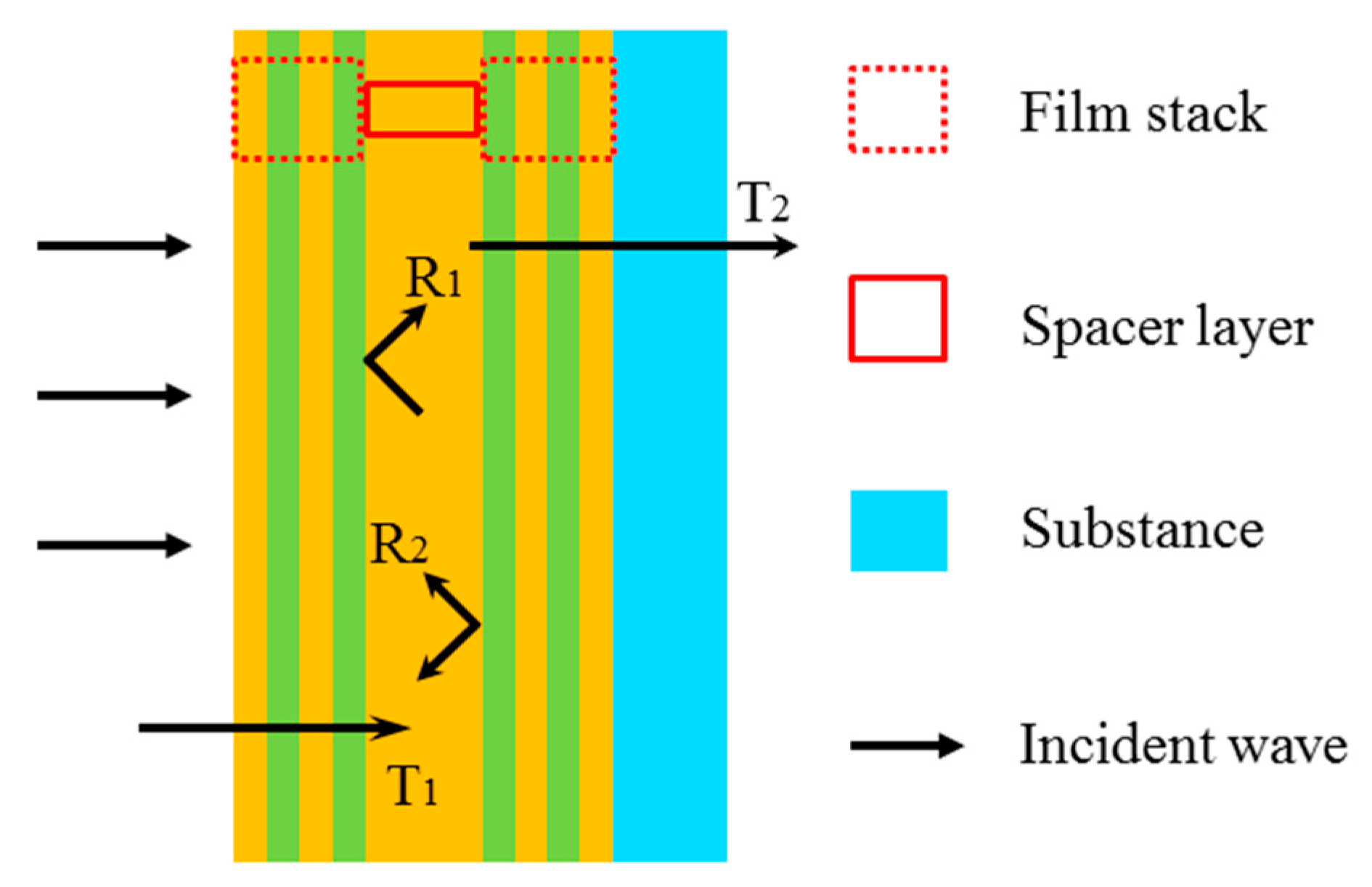
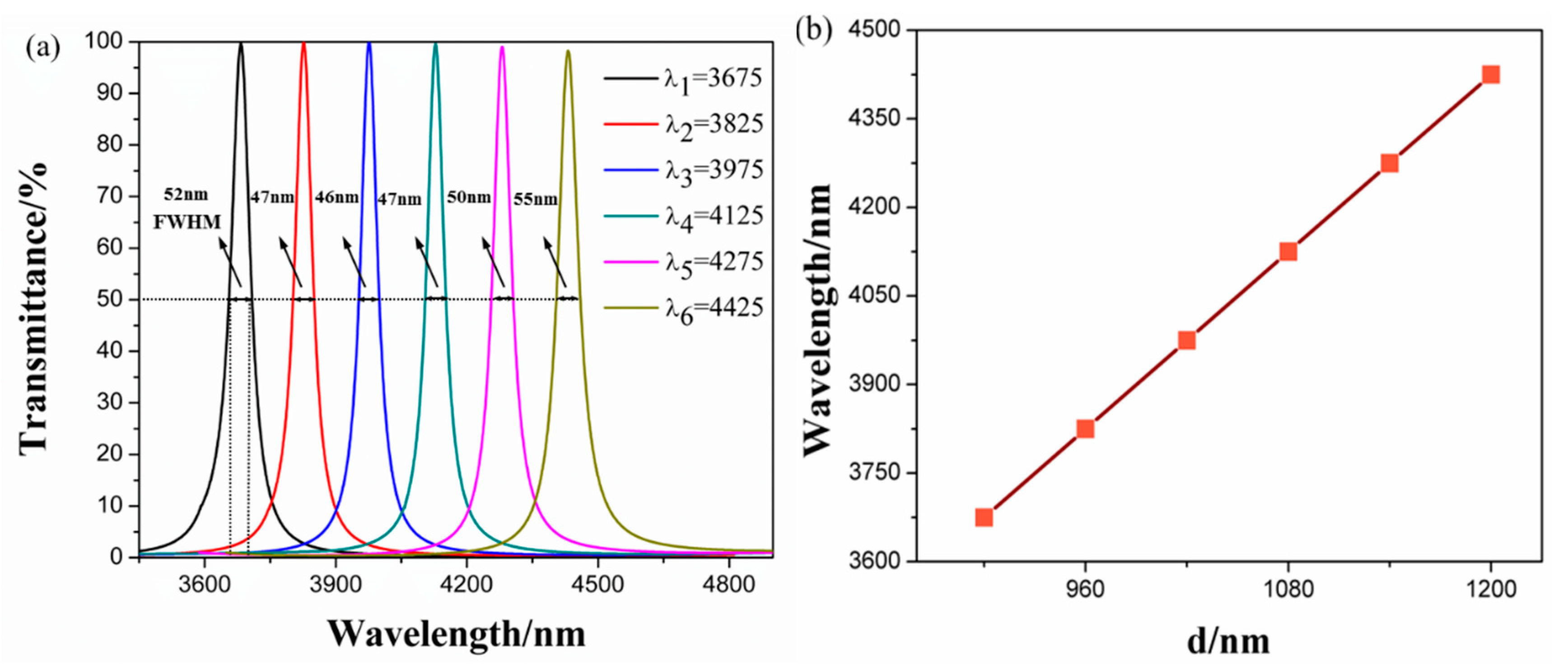
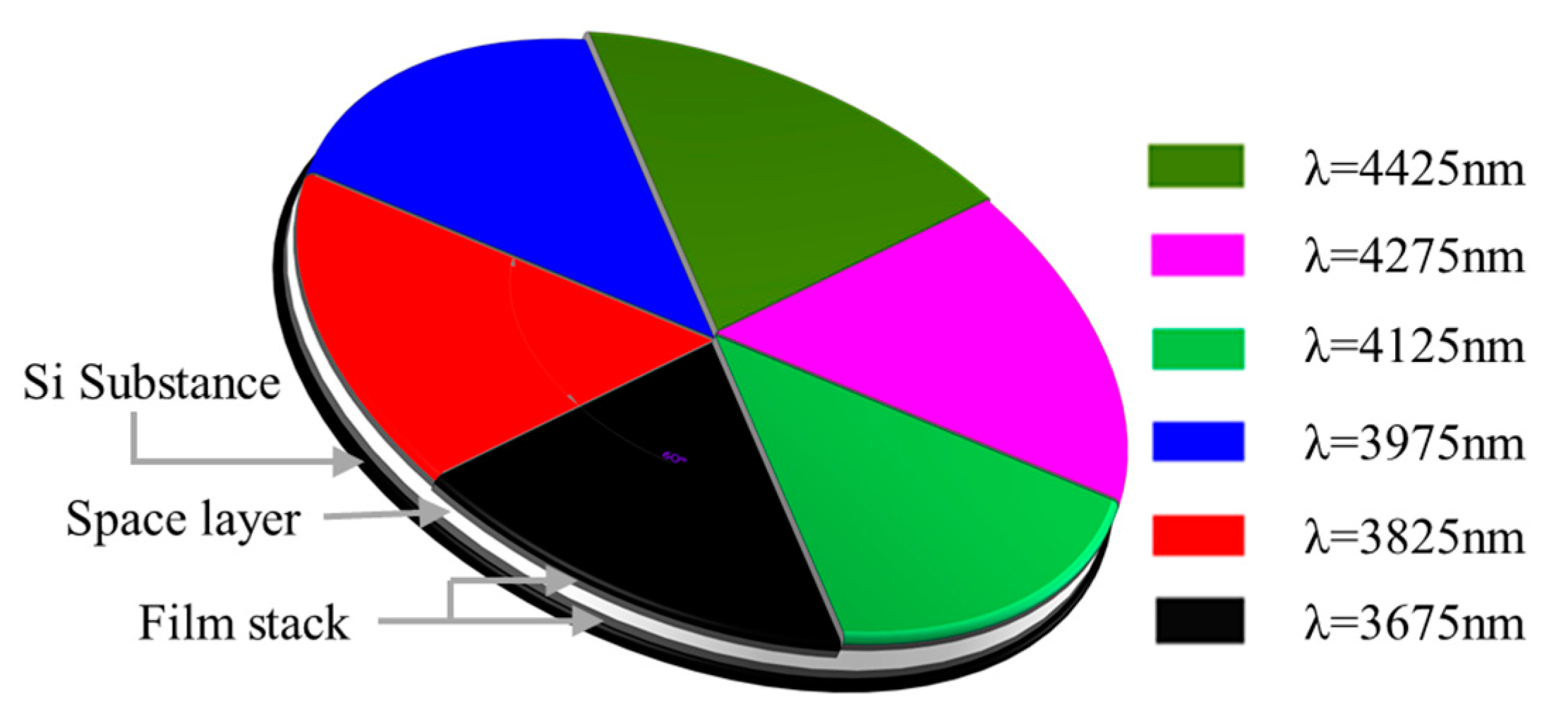

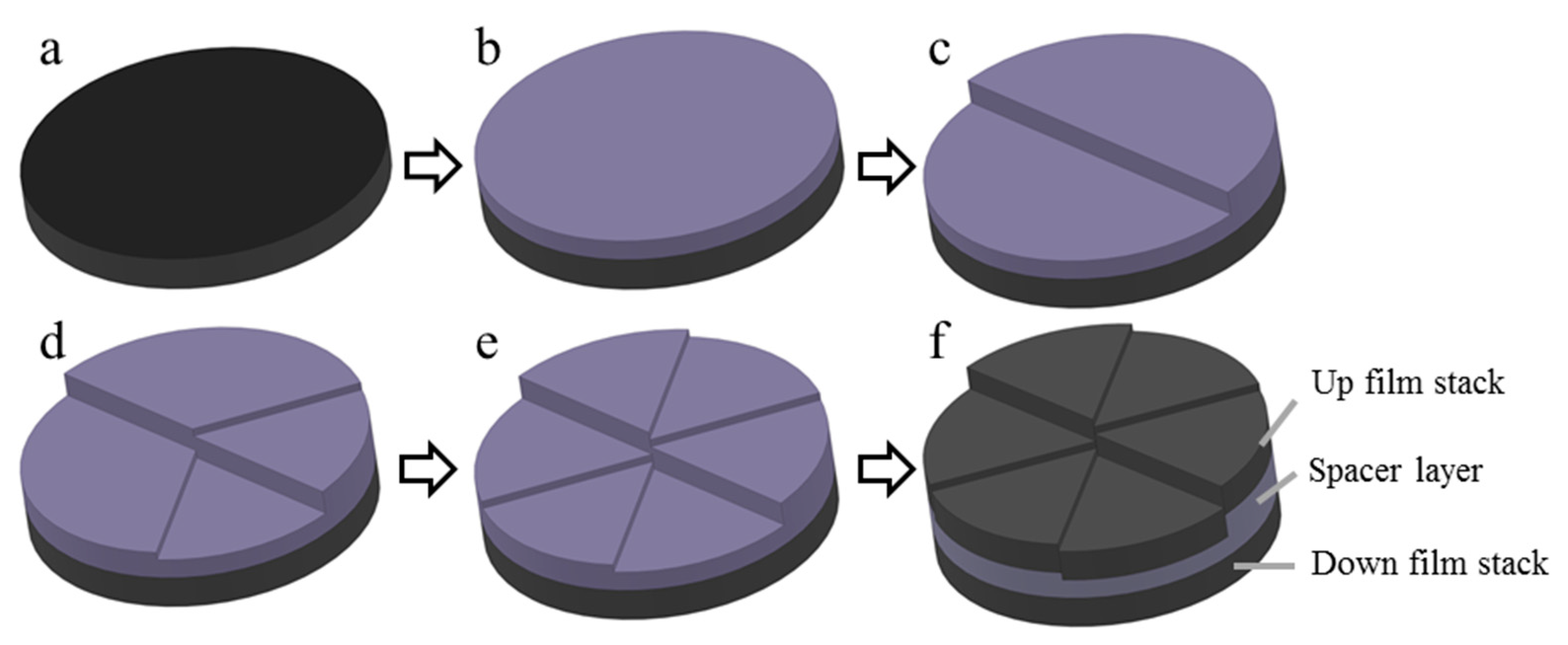
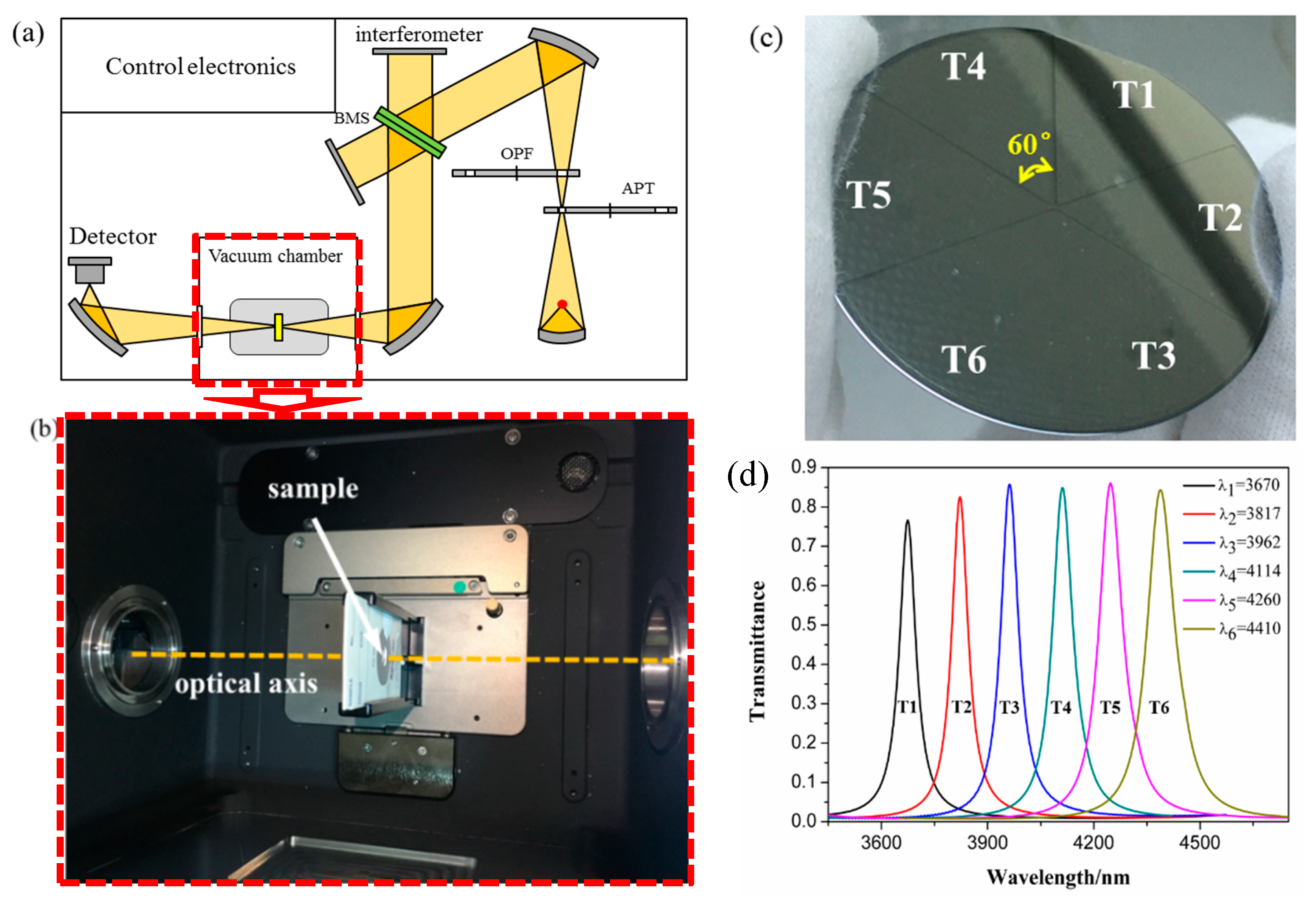
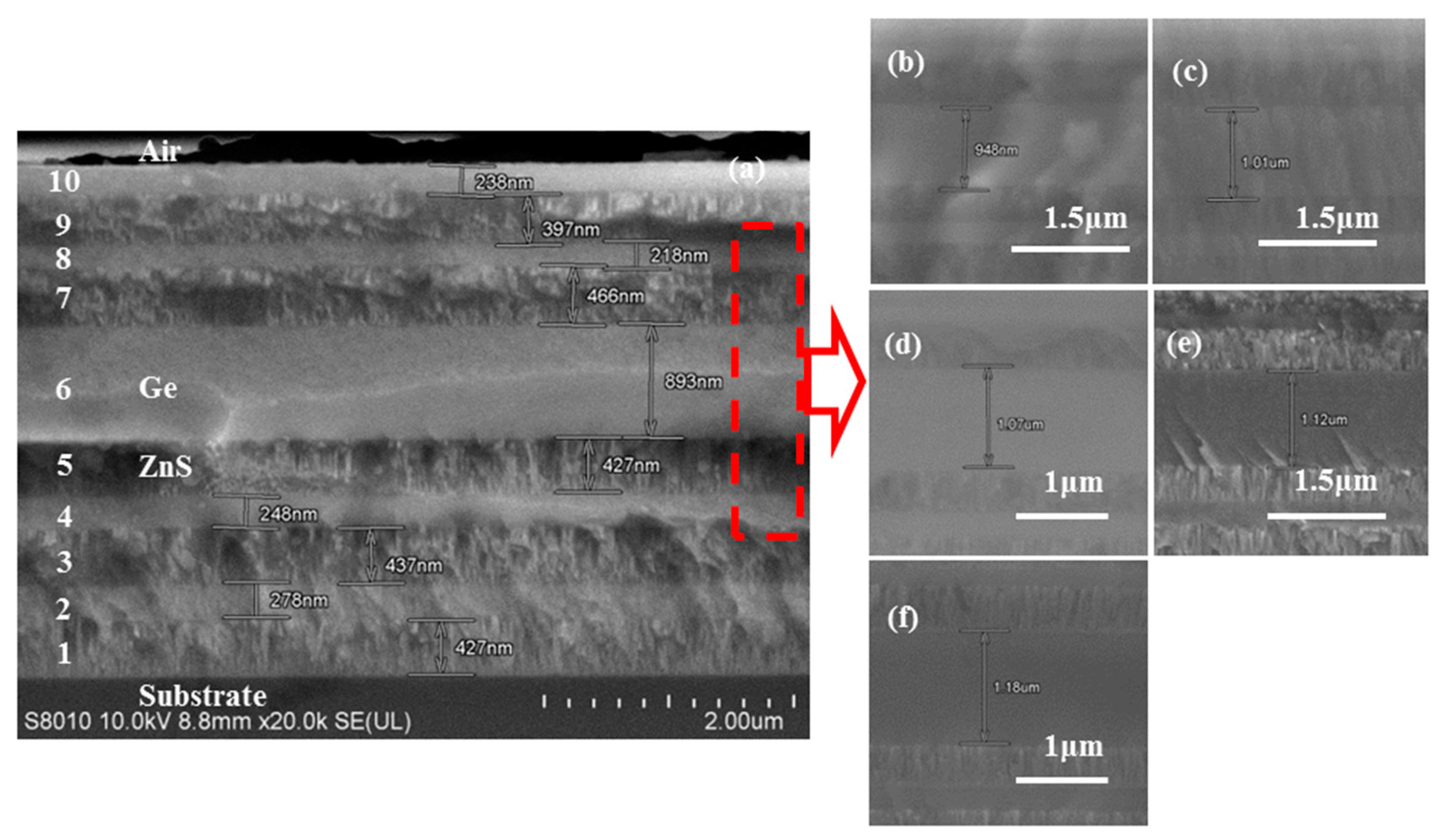
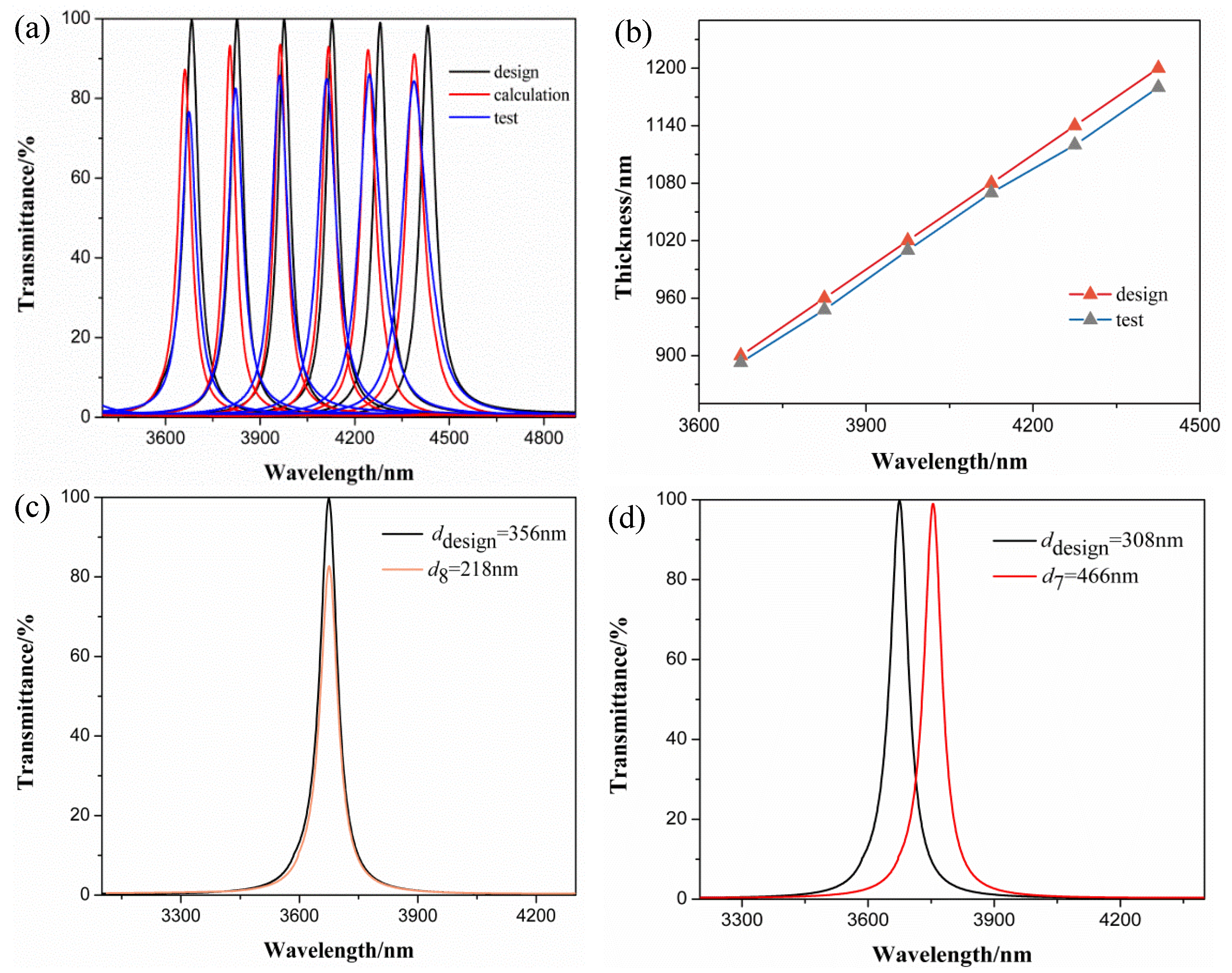
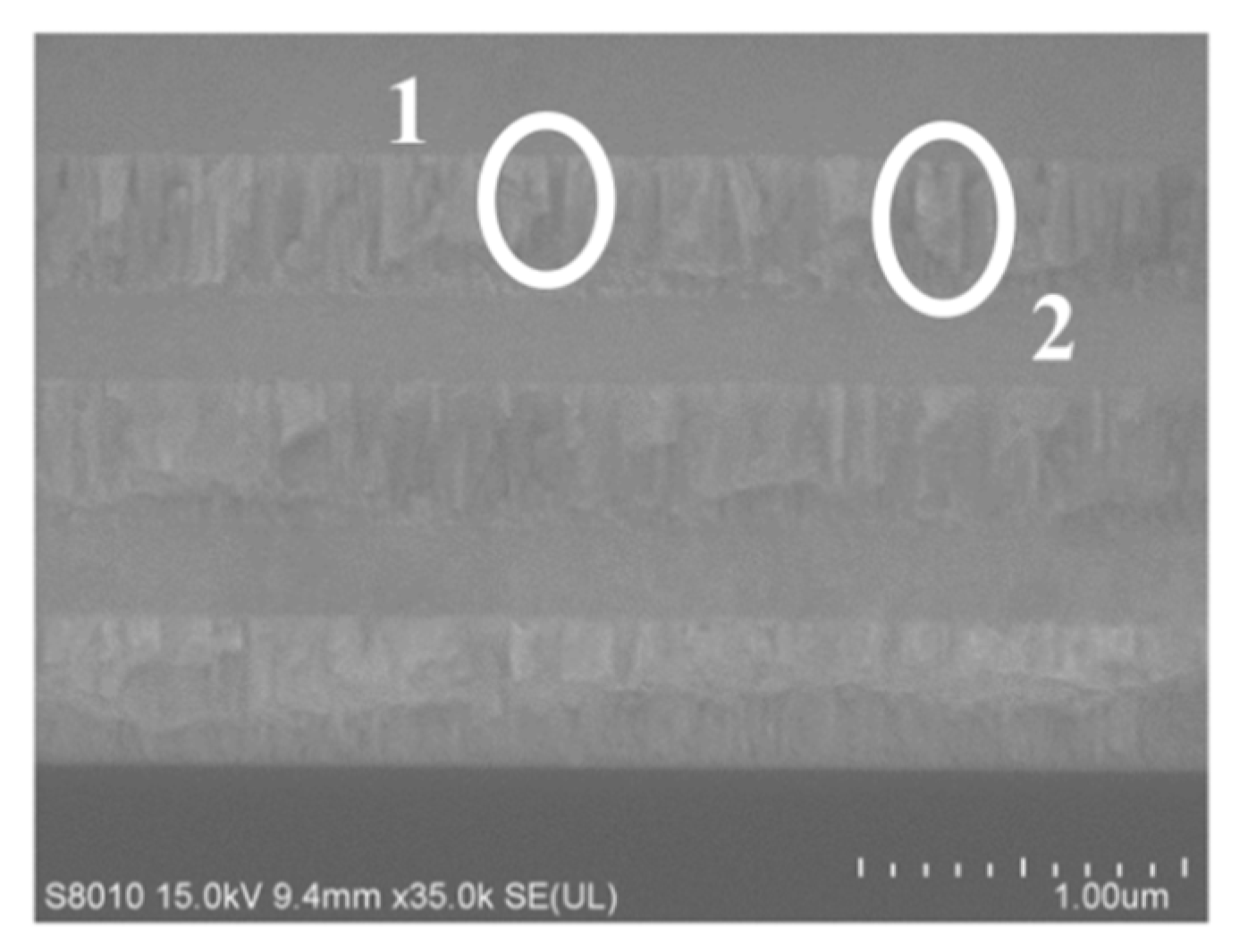
| Material | Base Pressure Vacuum (Pa) | Temperature (°C) | Evaporation Rate (nm/s) |
|---|---|---|---|
| Ge | 1.3 × 10−3 | 120 | 0.3 |
| ZnS | 3 × 10−3 | 105 | 0.4 |
| Y2O3 | 2 × 10−3 | 250 | 0.4 |
| Channel | T1 | T2 | T3 | T4 | T5 | T6 |
|---|---|---|---|---|---|---|
| Peak position (nm) | 3670 | 3817 | 3962 | 4114 | 4260 | 4410 |
| Transmittance (%) | 76.5 | 82.5 | 85.7 | 84.8 | 86.7 | 84.3 |
| FWHM (nm) | 55.98 | 55.64 | 60.27 | 69.3 | 79.64 | 93.53 |
| Film Number | Design Thickness (nm) | Test Thickness (nm) | Deviation (nm) |
|---|---|---|---|
| 1 | 432.04 | 427 | −5.04 |
| 2 | 271.75 | 278 | −6.25 |
| 3 | 447.15 | 437 | 10.15 |
| 4 | 248.11 | 248 | 0.11 |
| 5 | 435.54 | 427 | 8.54 |
| 6 | 900 | 893 | 7 |
| 960 | 948 | 12 | |
| 1020 | 1010 | 10 | |
| 1080 | 1070 | 10 | |
| 1140 | 1120 | 20 | |
| 1200 | 1180 | 20 | |
| 7 | 308.11 | 466 | −157.89 |
| 8 | 356 | 218 | 138 |
| 9 | 390.06 | 397 | −6.94 |
| 10 | 238.65 | 238 | 0.65 |
| Company Name | Peak Wavelength (nm) | Base Material | Filter Channel Characteristics | Positioning Accuracy (nm) | Peak Transmittance |
|---|---|---|---|---|---|
| Spectrogon | 3700 | Silicon | Single-channel | ±20 | 75% |
| 3860 | Sapphire | Single-channel | ±20 | 60% | |
| 4120 | Sapphire | Single-channel | ±20 | 70% | |
| 4270 | Sapphire | Single-channel | ±25 | 70% | |
| 4275 | Sapphire | Single-channel | ±15 | 70% | |
| 4515 | Sapphire | Single-channel | ±20 | 70% | |
| HB-Optical | 2100 | – | Single-channel | ±10 | 75% |
| 2200 | – | Single-channel | ±10 | 75% | |
| Alluxa | 1064 | Silicon | Single-channel | – | 85% |
| In this work | 3675 | Silicon | 6 channels integration | ±10 | 76.5% |
| 3825 | ±10 | 82.5% | |||
| 3975 | ±10 | 85.7% | |||
| 4125 | ±10 | 84.8% | |||
| 4275 | ±10 | 86% | |||
| 4425 | ±10 | 84.3% |
© 2019 by the authors. Licensee MDPI, Basel, Switzerland. This article is an open access article distributed under the terms and conditions of the Creative Commons Attribution (CC BY) license (http://creativecommons.org/licenses/by/4.0/).
Share and Cite
Duan, Y.; Cai, C.; Liang, H.; Jia, T.; Yin, S. Design and Preparation of a 6-Channel Fan-Shaped Integrated Narrow-Band Filter in the Mid-Infrared Band. Coatings 2019, 9, 567. https://doi.org/10.3390/coatings9090567
Duan Y, Cai C, Liang H, Jia T, Yin S. Design and Preparation of a 6-Channel Fan-Shaped Integrated Narrow-Band Filter in the Mid-Infrared Band. Coatings. 2019; 9(9):567. https://doi.org/10.3390/coatings9090567
Chicago/Turabian StyleDuan, Yingbu, Changlong Cai, Haifeng Liang, Tiantian Jia, and Shujing Yin. 2019. "Design and Preparation of a 6-Channel Fan-Shaped Integrated Narrow-Band Filter in the Mid-Infrared Band" Coatings 9, no. 9: 567. https://doi.org/10.3390/coatings9090567
APA StyleDuan, Y., Cai, C., Liang, H., Jia, T., & Yin, S. (2019). Design and Preparation of a 6-Channel Fan-Shaped Integrated Narrow-Band Filter in the Mid-Infrared Band. Coatings, 9(9), 567. https://doi.org/10.3390/coatings9090567





